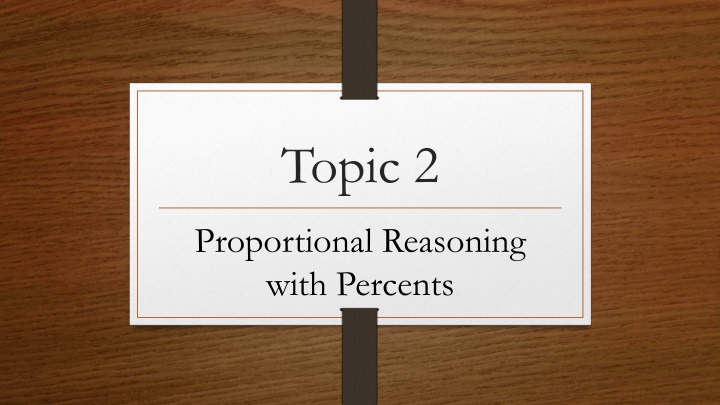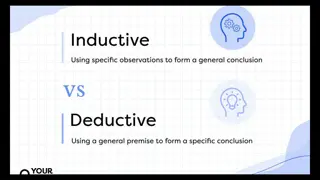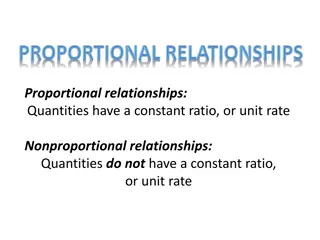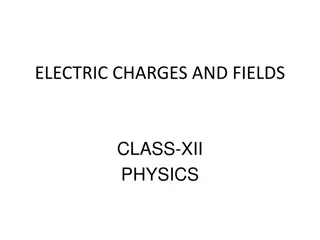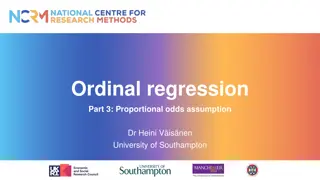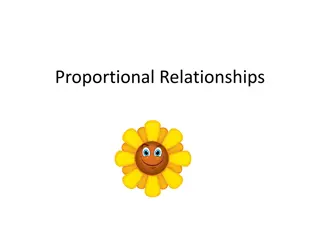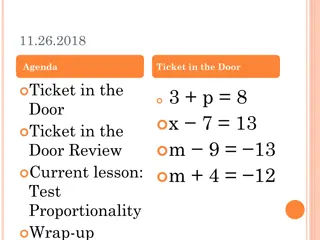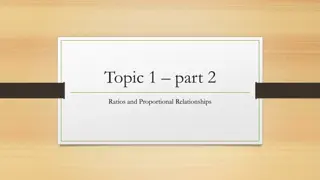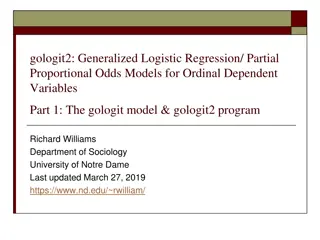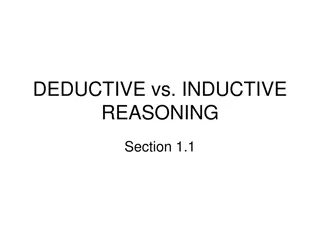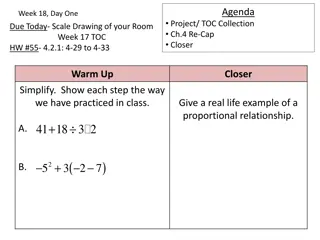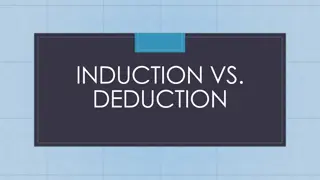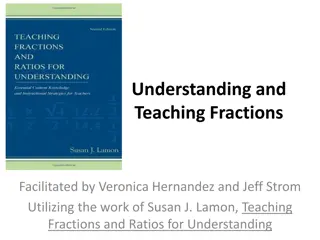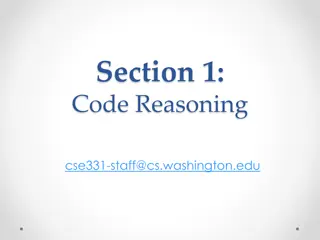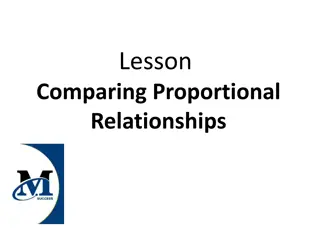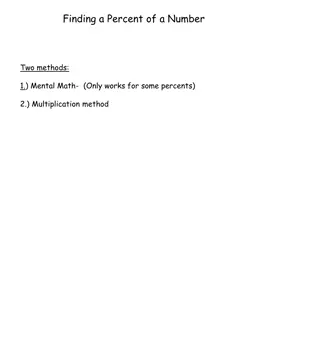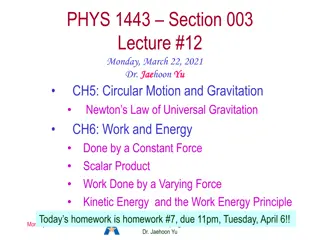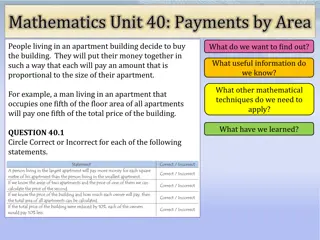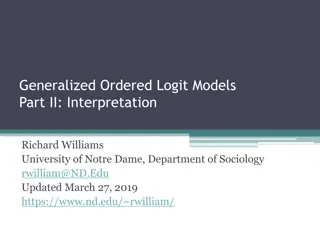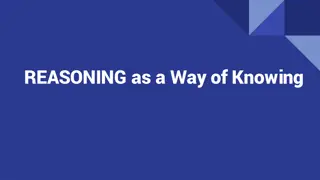Mastering Proportional Reasoning with Percents
Delve into the world of proportional reasoning with percents through examples like finding a percentage of a number, estimating percentages, and using percent proportions to compare quantities. Understand how to calculate percentages, estimate values, and solve problems involving percents effectively.
Download Presentation

Please find below an Image/Link to download the presentation.
The content on the website is provided AS IS for your information and personal use only. It may not be sold, licensed, or shared on other websites without obtaining consent from the author.If you encounter any issues during the download, it is possible that the publisher has removed the file from their server.
You are allowed to download the files provided on this website for personal or commercial use, subject to the condition that they are used lawfully. All files are the property of their respective owners.
The content on the website is provided AS IS for your information and personal use only. It may not be sold, licensed, or shared on other websites without obtaining consent from the author.
E N D
Presentation Transcript
Topic 2 Proportional Reasoning with Percents
7.2.1 Percent of a Number To find the percent of a number, you can: write the percent as a fraction and then multiply or write the percent as a decimal and then multiply.
Example 1 Find 25% of 80. 25% = 25 100 or 1 4Write 25% as a fraction, and reduce to lowest terms. 1 4 of 80 = 1 So, 25% of 80 is 20. 4 80 or 20 Multiply. Example 2 What number is 15% of 200? 15% of 200 = 15% 200 Write a multiplication expression. = 0.15 200 Write 15% as a decimal. = 30 Multiply. So, 15% of 200 is 30.
7.2.2 Percent and Estimation To estimate the percent of a number, you can use a fraction or a multiple of 10% or 1%. Involves rounding: To the nearest 10% Or 25% ( ), 50% ( ) ,75 ( ) Or 33% (1/3) or 663% (2/3) Can also round the number (instead of or in addition to the percent).
Example 1 Estimate 77% of 800. 77% is about 75% or 3 4. 77% of 800 3 600 Multiply. 4 800 Use 3 4to estimate. So, 77% of 800 is about 600.
Example 2 Estimate 137% of 50. 137% is more than 100%, so 137% of 50 is greater than 50. 137% 140%. 140% of 50 = (100% of 50) + (40% of 50) 140% = 100% + 40% 5 50100% = 1 and 40% = 2 = 50 + 20 or 70 2 = (1 50) + 5 Simplify. So, 137% of 50 is about 70.
Example 3 Estimate 0.5% of 692. 0.5% is half of 1%. 692 is about 700. 1% of 700 = 0.01 700 To multiply by 1%, move the decimal point two places to the left. = 7 One half of 7 is 1 So, 0.5% of 697 is about 3.5. 2 7 or 3.5.
7.2.3 The Percent Proportion A percent proportion compares part of a quantity to a whole quantity for one ratio and lists the percent as a number over 100 for the other ratio. part whole ? ?= ? 100percent
Example 1 What percent of 24 is 18? ? ?= 18 24= ? 100 Percent proportion Let n% represent the percent. ? 100 Write the proportion. 18 100 = 24 n Find the cross products. 1,800 = 24n Simplify. 1,800 24 75 = n So, 18 is 75% of 24. =24? 24 Divide each side by 24.
Example 2 What number is 60% of 150? ? ?= ? 150= n 100 = 150 60Find the cross products. 100n = 9,000 Simplify. ? 100 Percent proportion (Let n% represent the percent.) 60 100 Write the proportion. 100? 100=9,000 n = 90 So, 90 is 60% of 150. 100 Divide each side by 100.
7.2.4 The Percent Equation To solve any type of percent problem, you can use the percent equation, part = percent whole where the percent is written as a decimal.
Example 1 600 is what percent of 750? 600 is the part and 750 is the whole. Let n represent the percent. part = percent whole 600 = n 750 Write the percent equation. 600 750=750? Divide each side by 750. 750 0.8 = n Simplify. 80% = n Write 0.8 as a percent. So, 600 is 80% of 750.
Example 2 45 is 90% of what number? 45 is the part and 90% or 0.9 is the percent. Let w represent the whole. part = percent whole 45 = 0.9 w Write the percent equation 45 0.9=0.9? Divide each side by 0.9. 0.9 50 = w Simplify. So, 45 is 90% of 50.
7.2.5 Percent of Change A percent of change is a ratio that compares the change in quantity to the original amount. If the original quantity is increased, it is a percent of increase. If the original quantity is decreased, it is a percent of decrease.
To calculate percent of change: percent of change = amount amount of of increase original original amount increase or amount or decrease decrease x 100
Example 1 Last year, 2,376 people attended the rodeo. This year, attendance was 2,950. What was the percent of change in attendance to the nearest whole percent? Since this year's attendance is greater than last year's attendance, this is a percent of increase. The amount of change is 2,950 2,376 or 574. percent of change = amount of increase original amount = 574 2,376 0.24 or 24% The percent of increase is about 24%.
Example 2 Cheryl's grade on the first math exam was 94. Her grade on the second math exam was 86. What was the percent of change in Cheryl's grade to the nearest whole percent? Since the second grade is less than the first grade, this is a percent of decrease. The amount of change is 94 86 or 8. percent of change = amount of decrease original amount = 8 94 0.09 or 9% The percent of decrease is 9%.
7.2.6 Sales Tax, Tips, and Markup Sales Tax is a percent of the purchase price and is an amount paid in addition to the purchase price. Tip, or gratuity, is a small amount of money in return for service. This is added to price of service. The amount a store increases the price of an item by is called the markup. (The original amount is called the wholesale price.)
Example 1: Find the total cost of a $17.75 soccer ball if the sales tax is 6%. Method 1 First, find the sales tax. 6% of $17.75 = 0.06 17.75 1.07 The sales tax is $1.07. Next, add the sales tax to the regular price. 1.07 + 17.75 = 18.82 The total cost of the soccer ball is $18.82
Example 1: Find the total cost of a $17.75 soccer ball if the sales tax is 6%. Method 2 100% + 6% = 106% (Add the percent of tax to 100%.) The total cost is 106% of the regular price. 106% of $17.75 = 1.06 17.75 $18.82
7.2.7 Discount Discount is the amount by which the regular price of an item is reduced. The sale price is the regular price minus the discount.
Example: Find the price of a $69.50 tennis racket that is on sale for 20% off the regular price. Method 1: Subtract the discount from the regular price. First, find the amount of the discount. 20% of $69.50 = 0.2 $69.50 Write 20% as a decimal. = $13.90 The discount is $13.90. Next, subtract the discount from the regular price. $69.50 $13.90 = $55.60.
Example: Find the price of a $69.50 tennis racket that is on sale for 20% off the regular price. Method 2: Subtract the percent of discount from 100%. 100% 20% = 80% Subtract the discount from 100%. The sale price is 80% of the regular price. 80% of $69.50 = 0.80 69.50 = 55.60 The sale price of the tennis racket is $55.60.
7.2.8 Financial Literacy Simple interest is the amount of money paid or earned for the use of money. To find simple interest I, use the formula I = prt. Principal p is the amount of money deposited or invested. Rate r is the annual interest rate written as a decimal. Time t is the amount of time the money is invested in years.
Example 1 Find the simple interest earned in a savings account where $136 is deposited for 2 years if the interest rate is 7.5% per year. I = prt Formula for simple interest I = 136 0.075 2 Replace p with $136, r with 0.075, and t with 2. I = 20.40 Simplify. The simple interest earned is $20.40. Total amount in account is $136 + $20.40 = $156.40
Example 2 Find the simple interest for $600 invested at 8.5% (per year) for 6 months. 6 months = 6 12 or 0.5 year Write the time in years. I = prt Formula for simple interest I = 600 0.085 0.5 p = $600, r = 0.085, t = 0.5 I = 25.50 Simplify. The simple interest is $25.50. Total amount is $625.50.
